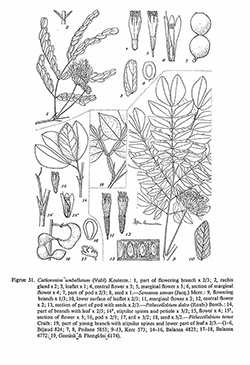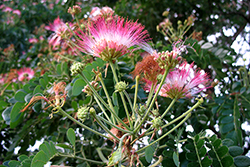e-Flora of Thailand
Volume 4 > Part 2 > Year 1985 > Page 202 > Leguminosae-Mimosoideae > Samanea
Samanea saman (Jacq.) Merr.wfo-0000194888
J. Wash. Acad. Sci. 6: 47. 1916; Back. & Bakh. f., Fl. Java 1: 550. 1963; Nielsen in Fl. C.L.V. 19: 106. Pl. 19, 9–13. 1981.— Mimosa saman Jacq., Fragm. Bot.: 15, t. 9. 1800–1809.— Pithecolobium saman (Jacq.) Benth., J. Bot. 3: 216. 1844; Trans. Linn. Soc. 30: 586. 1875.— Enterolobium saman (Jacq.) Prain, J. Asiat. Soc. Bengal 66 (2): 252. 1897; Gagnep. in Fl. Gén. I.-C. 2: 84. 1913; Ridl., Fl. Malay Penins. 1: 665. 1922 (in note); Craib in Fl. Siam. En. 1: 561. 1928. Fig. 51: 9–13.
Accepted Name : This is currently accepted.
Description : Large spreading tree up to ca 20 m high; branchlets puberulous to tomentose. Leaves: rachis ca 15 cm; gland (s) just below the junctions of the proximal pair of pinnae, and below the distal pair, or below all the pairs per pinnae, leaflets 2–10 pairs per pinna, 1.5–6 by 0.7–4 cm, obliquely ovate to elliptic to sub-rhomboid; base asymmetrical, rounded behind, truncate in front; apex obtuse-rounded, often emarginate, mucronate; upper surface glabrous, lower surface densely puberulous; main vein diagonal; lateral veins forming a prominent, dense, reticulate pattern. Central flower sessile. Calyx 8–9 mm, broadly tubular, tomentose-woolly; teeth 7–8, 0.5–1 mm, triangular, acute. Corolla ca 1.2 cm, tubular, glabrous below, tomentose woolly above. Staminal tube longer than the corolla. Ovary glabrous, sessile. Marginal flowers pedicellate. Calyx 5–7 mm, funnel-shaped, tomentose to woolly; teeth 0.5–1 mm, broadly triangular, acute. Corolla ca 10–12 mm funnel-shaped, nearly glabrous in the lower part, tomentose to woolly above; teeth ca 2 mm long, triangular-ovate. Staminal tube shorter than the corolla tube. Ovary sessile, glabrous. Pod 15–20 by 1.5–2.3 cm, oblong, black. Seeds ca 9 by 5 cm, elliptic, strongly biconvex, 4 mm thick; areole ca 7 by 3 mm, elliptic.
Thailand : Cultivated and naturalized all over the country.
Distribution : Native of N Tropical S America, but introduced all over the tropics. Type locality uncertain.
Ecology : In villages, along road-sides, spontaneous on stream and river banks, and in inundated areas.
Vernacular : Kam kram (ก้ามกราม), kam kung (ก้ามกุ้ง), kam pu (ก้ามปู), chamchuri (จามจุรี)(Central); cham cha (ฉำฉา), lang (ลัง), san sa (สารสา), sam sa (สำสา), tut tu (ตุ๊ดตู่)(Northern).
CommonName : Rain tree, East Indian Walnut.
Uses: Cultivated as shade trees and hosts of lac insects in the lac cultivation; wood for turnery.
Notes: The leaflets start to close before sunset, and may also close during the day when the sky is overcast, this latter feature has given the species the name “Rain-Tree”.


